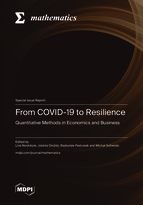From COVID-19 to Resilience: Quantitative Methods in Economics and Business
A special issue of Mathematics (ISSN 2227-7390). This special issue belongs to the section "Financial Mathematics".
Deadline for manuscript submissions: closed (30 November 2022) | Viewed by 33496
Special Issue Editors
Interests: multiple-criteria decision-making (MCDM) analysis; efficiency; banks; data envelopment analysis; input–output; non-parametric methods; behavioral economics; risk management; behavioral finance
Interests: risk management; agricultural finance; agricultural policy; international economics; international trade; foreign direct investments
Interests: capital markets; corporate finance; agricultural finance; sustainability
Special Issue Information
Dear Colleagues,
The COVID-19 pandemic represents a particularly important challenge for empirical research in economics and finance. The “resilience” category is often used in international documents concerning crisis management. The category of resilience enters numerous, usually overly complex interactions with many important socio-economic and public categories, important for various spheres of the economy, politics, and life of citizens. The aim of the Special Issue is to explore quantitative methods of measuring resilience, in the context of the COVID-19 pandemic. The measurement and assessment of resilience at different levels requires advanced quantitative and qualitative methods that are based on dynamic approaches and interaction with other socio-economic categories, which, consequently, makes it exceedingly difficult to develop public policies that are oriented towards strengthening resilience in general. A good example is the integrated measurement and assessment of economic and financial resilience of households by international organisations. There is a possible conflict in macro and micro approaches, which can be greatly beneficial at the application level to check the consistency of assumptions, approaches, and conclusions. In the context of public policy, the concept of resilience enables a more in-depth understanding of how economic entities cope with shocks and tensions.
This Special Issue aims at collecting original research papers, comprehensive reviews on the theory and practice on development and implementation of advanced mathematical and instrumental methods in the field of assessing resilience in various economic and business sectors. Applied quantitative methods will allow a better understanding of the interactions between economic and business socio-economic activities, and will contribute to the development of new models or the improvement of existing ones. These methods can be based on traditional modelling and forecasting tools, as well as on the new tools associated with the development of intelligent digital technologies, big data use, and so on.
Dr. Lina Novickytė
Dr. Jolanta Droždz
Prof. Dr. Radosław Pastusiak
Dr. Michał Soliwoda
Guest Editors
Manuscript Submission Information
Manuscripts should be submitted online at www.mdpi.com by registering and logging in to this website. Once you are registered, click here to go to the submission form. Manuscripts can be submitted until the deadline. All submissions that pass pre-check are peer-reviewed. Accepted papers will be published continuously in the journal (as soon as accepted) and will be listed together on the special issue website. Research articles, review articles as well as short communications are invited. For planned papers, a title and short abstract (about 100 words) can be sent to the Editorial Office for announcement on this website.
Submitted manuscripts should not have been published previously, nor be under consideration for publication elsewhere (except conference proceedings papers). All manuscripts are thoroughly refereed through a single-blind peer-review process. A guide for authors and other relevant information for submission of manuscripts is available on the Instructions for Authors page. Mathematics is an international peer-reviewed open access semimonthly journal published by MDPI.
Please visit the Instructions for Authors page before submitting a manuscript. The Article Processing Charge (APC) for publication in this open access journal is 2600 CHF (Swiss Francs). Submitted papers should be well formatted and use good English. Authors may use MDPI's English editing service prior to publication or during author revisions.
Keywords
- economic mathematics
- business mathematics
- financial mathematics
- digital economy
- risk management
- economic modelling and forecasting
- managerial economics
- resilience
- quantitative methods
- decision-making
- behavioral change
- practical applications (government, economics, development, agriculture, industry, services)







